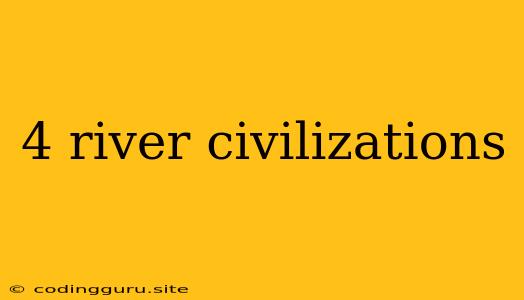The concept of 4 river civilizations is a historical model that categorizes the early civilizations of the ancient world based on their proximity to major rivers. While this model offers a simplified framework for understanding the rise of these civilizations, it's important to acknowledge its limitations and complexities.
What are the 4 River Civilizations?
The four river civilizations typically refer to:
- Mesopotamia: Located between the Tigris and Euphrates rivers in present-day Iraq, Mesopotamia is known for its advancements in writing, mathematics, astronomy, and law.
- Ancient Egypt: Located along the Nile River in present-day Egypt, Ancient Egypt is renowned for its monumental architecture, hieroglyphic writing system, and complex social hierarchy.
- Indus Valley Civilization: Flourishing along the Indus River in present-day Pakistan and northwest India, this civilization is known for its sophisticated urban planning, standardized weights and measures, and advanced sanitation systems.
- Yellow River Civilization: Located along the Yellow River (Huang He) in present-day China, this civilization is associated with the development of Chinese writing, silk production, and early forms of government.
Why were Rivers Crucial for these Civilizations?
Rivers played a vital role in the development of these early civilizations. They provided:
- Fertile land: The annual floods deposited rich silt, making the river valleys ideal for agriculture. This abundance of food allowed populations to grow and become settled.
- Water for irrigation: Rivers provided a reliable source of water for irrigation, ensuring consistent crop yields.
- Transportation: Rivers provided a convenient and efficient means of transporting goods and people.
- Trade: Rivers facilitated trade between different regions, leading to cultural exchange and economic growth.
Similarities and Differences among the 4 River Civilizations
While the 4 river civilizations shared common characteristics, they also displayed notable differences:
Similarities:
- Agricultural-based societies: All four civilizations relied heavily on agriculture for their survival and prosperity.
- Urban centers: Each civilization developed large, complex cities with specialized labor, social hierarchies, and public works.
- Religious beliefs: All four civilizations had complex religious beliefs and practices that influenced their social and political structures.
Differences:
- Political organization: Mesopotamia was characterized by independent city-states, while Egypt was a unified kingdom under a pharaoh. The Indus Valley Civilization and Yellow River Civilization had more complex political structures.
- Cultural achievements: Each civilization developed its own distinct culture, art, writing systems, and technological innovations.
Beyond the 4 River Civilizations
While the 4 river civilizations are often highlighted as the foundation of early human civilization, it's essential to acknowledge other civilizations that arose independently, like the Olmec civilization in Mesoamerica and the Nok culture in Africa. These civilizations also flourished due to their access to rivers, but their unique development demonstrates the diversity of early human societies.
Limitations of the 4 River Civilizations Model
The 4 river civilizations model, while helpful, has limitations. It:
- Oversimplifies: It focuses primarily on riverine civilizations, neglecting other important factors that contributed to the rise of early societies.
- Ignores regional diversity: Within each region, there existed significant cultural and political variations.
- Presents a linear view: The model suggests a sequential development of civilizations, while in reality, these civilizations coexisted and interacted.
Conclusion
The concept of 4 river civilizations offers a valuable framework for understanding the early development of human societies. However, it's crucial to recognize its limitations and acknowledge the complex interplay of factors that contributed to the rise of ancient civilizations. It's a starting point for exploring the rich and diverse history of our world.
